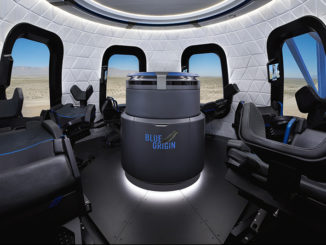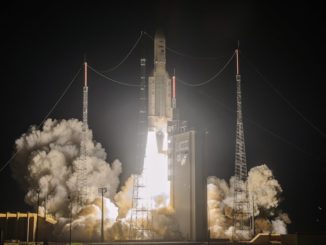EDITOR’S NOTE: Updated at 12:30 p.m. EDT (1630 GMT) after Cygnus release.
The Cygnus cargo freighter has been released from the International Space Station’s robotic arm, ending the spacecraft’s 83-day stay at the orbiting complex. WATCH LIVE: https://t.co/eyXXSFxOFR pic.twitter.com/XucgpieiSM
— Spaceflight Now (@SpaceflightNow) May 11, 2020
A Cygnus supply ship built by Northrop Grumman departed the International Space Station Monday, beginning an extended mission in orbit to deploy a pair of CubeSats and perform a NASA-sponsored fire experiment.
The automated cargo carrier was released from the space station’s Canadian-built robotic arm at 12:09 p.m. EDT (1609 GMT) Monday. The Cygnus spacecraft arrived at the space station Feb. 18, three days after launching aboard an Antares rocket from Wallops Island, Virginia.
The Cygnus spacecraft is named the S.S. Robert Lawrence Jr., in honor of the first African American selected as an astronaut in a U.S. space program.
The cargo freighter delivered to the space station 7,445 pounds (3,377 kilograms) of hardware, supplies and experiments inside the spacecraft’s pressurized module, made in Italy by Thales Alenia Space.

Northrop Grumman has multibillion-dollar contracts with NASA for a series of resupply missions to the space station. The agreements cover at least 17 resupply flights through 2024, and the NG-13 mission set to conclude this month marks the 13th mission under the cargo transportation contracts. One Cygnus mission suffered an Antares launch failure in 2014.
During the Cygnus spacecraft’s 83-day stay at the space station, astronauts unpacked the gear loaded inside the ship’s pressurized cargo compartment, and replaced it with trash and other unnecessary equipment for disposal.
After leaving the station, the Cygnus spacecraft will change its orbit to fly a safe distance away before kicking off an extended mission.
The Cygnus will deploy CubeSats Wednesday and host a NASA combustion experiment inside its pressurized cabin before Northrop Grumman controllers command the spacecraft to a destructive re-entry over the South Pacific Ocean on May 29.
The CubeSats will eject from a Slingshot deployer mounted on the Cygnus spacecraft’s forward hatch. The Slingshot deployed, developed by SEOPS LLC, will release a pair of nanosatellites, according to NASA.
The pair of small spacecraft “will research ways to improve space communication techniques and GPS mapping systems,” NASA said.
The NASA flame combustion experiment housed inside the Cygnus pressurized module will examine how flames propagate in microgravity. It’s the fourth in a series of NASA Saffire experiments developed at the Glenn Research Center in Ohio that have flown on Cygnus missions.
Previous combustion investigations in space have been limited in size and scope because of concerns about the dangers to astronauts. But the Cygnus will be far away from the space station when the Sapphire experiment begins, allowing scientists to ignite larger samples to see how flames behave in space.
For the first time, the Sapphire experiment on the NG-13 mission will ignite four burn samples, two of which will be ignited with the the air pressure inside the Cygnus spacecraft equivalent to sea level on Earth. Then the Cygnus module will be partially depressurized — and its oxygen content increased — to see how the oxygen-rich, lower-pressure environment affects the combustion of the other two samples.
The experiment will also test fire detection technology for use on future spacecraft, and automated fire clean-up systems.
Email the author.
Follow Stephen Clark on Twitter: @StephenClark1.



